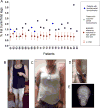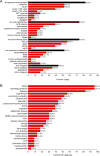Spectrum of disease associated with partial lipodystrophy: lessons from a trial cohort
- PMID: 28199729
- PMCID: PMC5395301
- DOI: 10.1111/cen.13311
Spectrum of disease associated with partial lipodystrophy: lessons from a trial cohort
Abstract
Context: Partial lipodystrophy (PL) is associated with metabolic co-morbidities but may go undiagnosed as the disease spectrum is not fully described.
Objective: The objective of the study was to define disease spectrum in PL using genetic, clinical (historical, morphometric) and laboratory characteristics.
Design: Cross-sectional evaluation.
Participants: Twenty-three patients (22 with familial, one acquired, 78·3% female, aged 12-64 years) with PL and non-alcoholic fatty liver disease (NAFLD).
Measurements: Genetic, clinical and laboratory characteristics, body composition indices, liver fat content by magnetic resonance imaging (MRI), histopathological and immunofluorescence examinations of liver biopsies.
Results: Seven patients displayed heterozygous pathogenic variants in LMNA. Two related patients had a heterozygous, likely pathogenic novel variant of POLD1 (NM002691·3: c.3199 G>A; p.E1067K). Most patients had high ratios (>1·5) of percentage fat trunk to percentage fat legs (FMR) when compared to reference normals. Liver fat quantified using MR Dixon method was high (11·3 ± 6·3%) and correlated positively with haemoglobin A1c and triglycerides while leg fat by dual-energy X-ray absorptiometry (DEXA) correlated negatively with triglycerides. In addition to known metabolic comorbidities; chronic pain (78·3%), hypertension (56·5%) and mood disorders (52·2%) were highly prevalent. Mean NAFLD Activity Score (NAS) was 5 ± 1 and 78·3% had fibrosis. LMNA-immunofluorescence staining from select patients (including one with the novel POLD1 variant) showed a high degree of nuclear atypia and disorganization.
Conclusions: Partial lipodystrophy is a complex multi-system disorder. Metabolic parameters correlate negatively with extremity fat and positively with liver fat. DEXA-based FMR may prove useful as a diagnostic tool. Nuclear disorganization and atypia may be a common biomarker even in the absence of pathogenic variants in LMNA.
© 2017 The Authors. Clinical Endocrinology Published by John Wiley & Sons Ltd.
Figures





References
-
- Chan JL, Oral EA. Clinical classification and treatment of congenital and acquired lipodystrophy. Endocr Pract. 2010;16(2):310–23. - PubMed
-
- Vigouroux C, Caron-Debarle M, Le Dour C, et al. Molecular mechanisms of human lipodystrophies: from adipocyte lipid droplet to oxidative stress and lipotoxicity. Int J Biochem Cell Biol. 2011;43(6):862–76. - PubMed
-
- Farhan SM, Robinson JF, McIntyre AD, et al. A novel LIPE nonsense mutation found using exome sequencing in siblings with late-onset familial partial lipodystrophy. Can J Cardiol. 2014;30(12):1649–54. - PubMed
MeSH terms
Supplementary concepts
Grants and funding
LinkOut - more resources
Full Text Sources
Other Literature Sources
Miscellaneous

